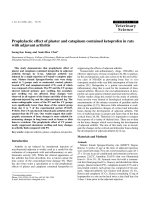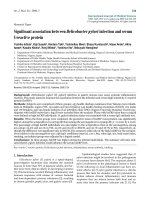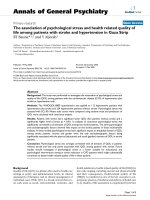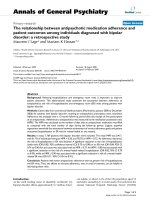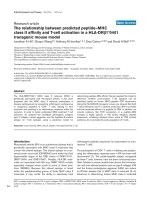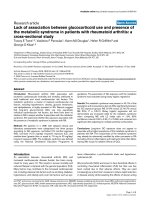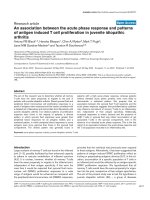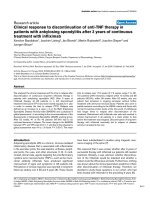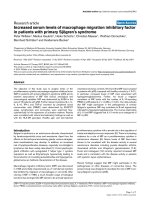Báo cáo y học: "The association between microvascular and macrovascular endothelial function in patients with rheumatoid arthritis: a cross-sectional study" pdf
Bạn đang xem bản rút gọn của tài liệu. Xem và tải ngay bản đầy đủ của tài liệu tại đây (180.82 KB, 5 trang )
RESEA R C H ART I C L E Open Access
The association between microvascular and
macrovascular endothelial function in patients
with rheumatoid arthritis: a cross-sectional study
Aamer Sandoo
1,2*
, Douglas Carroll
2
, George S Metsios
1
, George D Kitas
1,3
and Jet JCS Veldhuijzen van Zanten
1,2
Abstract
Introduction: Patients with rheumatoid arthritis (RA) are at an increased ris k for cardiovascular disease (CVD). One
of the earliest manifestations of CVD is endothelial dysfunction (ED). ED can occur in both the microcirculation and
the macrocirculation, and these manifestations might be relatively independent of each other. Little is known
about the association between endothelial function in the microcirculation and the macrocirculation in RA. The
objectives of the present study were to examine the relationship between microvascular and macrovascular
endothelial function in patients with RA.
Methods: Ninety-nine RA patients (72 females, mean age (± SD) 56 ± 12 years), underwent assessments of
endothelial-dependent (acetylcholine) and endothelial-independent (sodium nitroprusside) microvascular
vasodilatory function (laser Doppler imaging with iontophoresis), as well as endothelial-dependent (flow-mediated
dilation) and endothelial-independent (glyceryl trinitrate-mediated dilation) macrovascular vasodilatory function.
Vasodilatory function was calculated as the percentage increase after each stimulus was applied relative to baseline
values.
Results: Pearson correlations showed that microvascular endothelial-dependent function was not associated with
macrovascular endothelial-dependent function (r (90 patients) = 0.10, P = 0.34). Similarly, microvascular endothelial-
independent function was not related to macrovascular endoth elial-independent function (r (89 patients) = 0.00,
P = 0.99).
Conclusions: Microvascular and macrovascular endothelial function were independe nt of each other in patients
with RA, suggesting differential regulation of endothelial function in these two vascular beds. Assessments of both
vascular beds may provide more meaningful clinical information on vascular risk in RA, but this hypothesis needs
to be confirmed in long-term prospective studies.
Introduction
The endothelium is the innermost lining of the vasculature
and is responsible for maintaining vascular homeostasis
via the balanced production of a number of vasoactive fac-
tors [1]. One such factor is nitric oxide (NO), which plays
an important role in vasodilation and in inhibiting athero-
sclerotic processes such as thrombosis and leukocyte acti-
vation in the vessel wall [2-5]. Damage to the endothelium
can reduce NO activity, causing endothelial dysfunction
(ED), which is an early indicator of cardiovascular disease
(CVD) [6]. The extent of ED can be characterised by asses-
sing endothelial function in differ ent vascular beds of the
peripheral circulation [7]. These assessments are reflective
of coronary endothelial function [8-11] and have been
shown to be good predictors of long-term cardiovascular
events in individuals with atherosclerosis [12-15] and per-
ipheral vascular disease [16], as well as in healthy older
participants [17].
Endothelial cells can differ in structure and phenotype,
depending on the vessel type [18]. Heterogeneous
responses to in vitro stimulation are displayed in different
vascular beds and even in different sections of the same
vascular bed [19-21]. This suggests that ED may occur
differentially in different vascular beds [21]. Studies that
* Correspondence:
1
Department of Rheumatology, Dudley Group of Hospitals NHS Trust,
Russells Hall Hospital, Pensnett Road, Dudley, DY1 2HQ, West Midlands, UK
Full list of author information is available at the end of the article
Sandoo et al. Arthritis Research & Therapy 2011, 13:R99
/>© 2011 Sandoo et al.; licensee BioMed Centr al Ltd. This is an open access article distributed under the terms of t he Creative Commons
Attribution License (http://creati vecommons.org/licenses/by/2.0), which permits unrestrict ed use, distribution, and reproduction in
any medium, provided the original work is properly cited.
have assessed associations between peripheral microvas-
cular and macrovascular endoth elial-dependent function
in healthy individuals have reported mixed findings, with
some reporting an association between microvascular
and macrovascular endothelial-dependent function
[22,23] and others reporting no association [24-26].
Rheumatoid arthritis (RA) is a chronic systemic inflam-
matory disease of the joints [27]. RA patients are also at
an increased risk for CVD [28], with ED believed to be a
contributor to some of this excess CVD ri sk [29]. RA has
a similar CVD risk burden and vascular profile to dia-
betes [30], a condition in which microvascular disease
may contribute to macrovascular disease [31]. There is
also some preliminary evidence that coronary microvas-
cular disease may be apparent b efore macrovascular dis-
ease in RA [32]. This highlights the importance of
assessing endothelial function in multiple vascular beds.
To our knowledge, only two studies have simultaneously
assessed microvascular and macrovascular endothelial
function in RA; one study reported no association between
the two vascular beds [33], while the other study did find
an association [34]. In the former study, microvascular
endothelial function was measured using l aser Doppler
flowmetry, which assesses endothelial function at a single
point only and does not account for spatial heterogeneity
of skin blood flow in the way th at newer techniques such
as laser Doppler imaging (LDI) do [35]. A limitation of the
second study is that manual methods were used to detect
and mark out the vessel diameter during flow-mediated
dilation (FMD). This method is less accurate than auto-
mated wall tracking software, which detects and calculates
arterial diameter in real time and greatly reduces the varia-
bility found in the measurements [36,37]. Such limitations
suggest that the association between microvascular and
macrovascular endothelial function requires further inves-
tigation using newer and more accurate assessments of
endotheli al function. Accordingly, the aim of the present
study was to examine the relationship between microvas-
cular and macrovascular endothelium-dependent function
in RA using LDI and automated measurements of vascular
diameter changes to reactive hyperaemia.
Material and methods
Patients
Ninety-nine consecutive rheumatoid arthritis (RA)
patients were recruited from the rheumatology outpati-
entclinicsoftheDudleyGroupofHospitalsNHS
Trust, UK. All patients met the retrosp ective application
of the 1987 revised RA criteria of the American Rheu-
matism Association [38]. Patients were excluded if they
had previously confirmed acute coronary syndrome or
established CVD as indicated in their medical records
and/or upon questioning during the initial consultation.
The study received local Research Ethics Committee
approval, and all participants gave their written
informed consent according to the Declaration of
Helsinki.
Protocol
Patients reported to a temperature-controlled vascular
laboratory (22°C) after a 12-hour overnight fast. For
ethical re asons, patients were not asked to refrain from
tak ing RA disease-re lated or vasoactive medications. All
patients underwen t a detailed clinical examination, and
demographic information was collected from all the par-
ticipants b y questionnaire. The disease activity score in
28 joints [39] was also calcu lated. Following this step,
the participants underwent assessments of microvascular
endothelial function using LDI with iontophoresis and
assessment of macrovascular endothelial function using
FMD and glyceryl trinitrate-mediated dilation (GTN).
Microvascular endothelial function
Endothelial function of the microvasculature was
assessed no ninvasively using LDI (moorLDI2 SIM; Moor
InstrumentsLtd,Devon,UK)withiontophoresisof1%
acetylcholine (Ach; endothelium-dependent) and 1%
sodium nitroprusside (SNP; endothelium-independent)
(Sigma Chemical Co., Montvale, NJ, USA) in 0.5 mL of
saline by a single observer (AS). The technique was per-
formed according to previously e stablished guidelines
[35] and was described in detail previously [ 40]. Briefly,
after a baseline scan, ten scans were recorded during
iontophoresis of the vasoactive agents using a 30 μA
current, followed by two scans during recovery. This
technique has intraobserver coefficients of variation
(CVs) of 6.5% and 5.9% for ACh and SNP, respectively,
in our laboratory.
Macrovascular endothelial function
Assessment of macrovascular endothelial-dependent
function was performed using FMD with high-resolution
ultrasonography of the brachial artery (ACUSON
Antares ultrasound system; Siemens PLC, Camberley,
UK) according to previously established guidelines [41].
Following te n minutes of rest, endothelium-independent
respons es were examined by administration of a 500-μg
sublingual glyceryl trinitrate tablet (Alpharma, Barnsta-
ple, UK) while the brachial artery was imaged continu-
ously for five minutes. The intraobserver CVs were
10.7% for FMD and 11.8% for GTN assessments, respec-
tively. For all vascular tests, endothelial function was
expressed as the percentage increase in perfusion or dia-
meter from baseline, and all analysis was carried out off-
line by AS , who was blinded to the identity of the
patient.
Sandoo et al. Arthritis Research & Therapy 2011, 13:R99
/>Page 2 of 5
Statistical analysis
Stati stical analysis was performed using SPSS version 16
software (SPSS Inc, Chicago, IL, USA). Variables were
tested for normality by using the Kolmogorov-Smirnov
test. Log transformation was performed for p ositively
skewed variables as appropriate. Values are expre ssed as
medians (25th to 75th percentiles) or percenta ges as
appropriate. Pearson’s correlations were used to assess
the relationships between mic rovascular and macrovas-
cular endothelium-dependent function.
Results
The patient characteristics are presented in Table 1. The
majority of patients were fem ale and had moderate dis-
ease activity levels. The percentage increase in blood
flo w in response to ACh was 311 ± 234, and for SNP it
was 306 ± 199. For macrovascular endothelial function,
the percentage increase in diameter (FMD) after reactive
hyperaemia was 9 ± 6, and the percentage increase in
diameter after GTN was 23 ± 9. Microvascular and
macrovascular endothelial function for RA patients were
similar to a healthy control group (data not reported).
As shown in Table 2, microvascular endothelium-
dependent function was not associated with macrovas-
cular endothelium-dependent function. This was a lso
the case with regard to associations between endothe-
lium-independent function in these two vascular beds.
Discussion
In the present study, we found that in RA patients,
microvascular and macrovascular endothelial function
are not associated with each other. To our kn owledge,
only two other studies have examined associations
between small-and large-vessel endothelial function in
RA patients. One study of 65 RA patients used laser
Doppler flowmetry to assess microvascular blood flow
and reported findings similar to those of the current
study [33], whereas another study of 66 RA patients
reported that microvascular and macrov ascular endothe-
lium-dependent function were only moderately asso-
ciated with each other [34].
Arosio and colleagues [33] examined both microvascu-
lar and macrovascular endothelial function by eliciting
reactive hyperaemia. Even though both assessments
were dependent on shear stress, microvascular and
macrovascular endothelial function were not associated
with each other [33] , which could be due to a difference
in exposure to shear stress between the resistance and
conduit v essels [42]. Given that the magnitude of shear
stress is directly linked to NO release [43], it is possible
that differences in shear stress profiles resulted in the
lack of association between these two assessments in the
study by Arosio and colleagues [33]. Therefore, it is pos-
sible t hat microvascular and macrovascular endothelial
function may differ even when a similar stimulus is
used.
Foster and colleagues [34] used the same assessments
as we used in the present study [34], but the iontophor-
esis protocol used to administer the vasoactive agents
diff ered between studies in terms of relative administra-
tion of the iontophoresis agents (simultaneously in the
current study versus consecutively in the previous
study), as did the iontophoresis current delivery (30 μ A
vs. 100 μA, respectively). Higher currents can lead to
vasodilation from other endothel ium-dependent factors,
such as bradykinin and substance P [35]. Importantly,
artefactual vasodilation from high currents is amplified
when water is used as the drug vehicle [44], as in the
Foster and colleagues study, but is eliminated when
0.5% sodium chloride is used [44], as in the present
study. Thus, differences in protocol make comparing the
findings of both studies difficult.
In the present study, differences in NO stimulation
between the assessments could have contributed to the
independence of the microvessels a nd macrovessels
through differential effects on endothelial cell receptors.
Whereas SNP, FMD and GTN predominantly evoke
maximum NO release [8,43], NO inhibition reduces
only 30% to 40% of the microvascular vasodilatory
response induced by ACh [45], suggesting that other
factors, such as endotheliu m-derived hyperpolarising
factor, may also contribute to vasodilation in the resis-
tance vessels [46]. In addition, application of pharmaco-
logic (ACh and SNP) [47] and physiologic (shear stress)
[48] stimuli activate different endothelial receptors [49],
and consequently there may be differences in the vaso-
dilatory response between the two assessments.
In the current work, participants were not asked to
withhold their antirheumatic drug treatment or vasoac-
tive medications pr ior to the vascular assessments, as
examining patients while they maintain their normal
medication regime may provide a better reflection of the
Table 1 General and disease-related characteristics for
the RA patients
a
Characteristics RA patient data
General characteristics
Age, years 57 (47 to 65)
Females, % 73%
Body mass index 29 (25 to 34)
Disease-related characteristics
Disease duration, years 8 (3 to 16)
Rheumatoid factor-positive, % 78%
DAS28 score 3.6 (2.5 to 4.6)
C-reactive protein level, mg/L 5 (2.9 to 13.5)
Erythrocyte sedimentation rate, mm/hour) 17 (8.8 to 28.3)
a
DAS28 = disease activity score in 28 joints; RA = rheumatoid arthritis. Results
are expressed as medians (25th to 75th percenti les).
Sandoo et al. Arthritis Research & Therapy 2011, 13:R99
/>Page 3 of 5
patient’s a rterial condition in an everyday setting. How-
ever, additional analyses were conducted to explore the
influence of vasoactive medication on the association
between microvascular and macrovascular function.
Excluding patients receiving vasocative medication (n =
46) did not change the findings (da ta not reported).
Another potential limitation of this study is the sample
size. However, the ef fect size of the correlations in the
current data is small [50]. This means that, with a
powerof0.80anda set at 0.05, the required sample
size to detect a significant association would be 783 par-
ticipants [50]. Thus, this suggests that the null findings
presented in the current study are due to effect size
rather than to sample size.
As stated above, assessments of endothelial function
have been reported to be good pr edictors of long-term
cardiovascular events in individuals with CVD [12-16]
and in healthy older participants [17]. However, in RA,
to our knowledge, no studies have examined whether
poor endothelial functio n relates to long-term adverse
CV outcomes. Only one study with a relatively small
sample size examined the prognostic value of carotid
intima media thickness (CIMT), which is an indicator of
vascular morphology rather than function [51]. That
study showed that patients who experienced a cardiac
event during a five-year follow-up period also had
greater CIMT at baseline co mpared to patients without
a cardiac event [51]. Therefore, to understand whether
and how vascular function is predictive of cardiovascular
events, detailed longitudinal assessments are necessary
and should include assessment of both the microvascu-
lature and the macrovasculature.
Conclusions
In summary, the present study has shown that micro-
vascular and macrovascular endothelial function were
not associated with each other in patients with RA, sug-
gesting that these assessments cannot be used inter-
changeably in this population. Assessments of both
vascular beds may provide more meaningful clinical
informatio n on vas cular risk in RA, but this needs to be
confirmed in long-term prospective studies.
Abbreviations
Ach: acetylcholine; CIMT: carotid intima media thickness; CVD: cardiovascular
disease; CV: coefficient of variation; DAS28: disease activity score in 28 join ts;
ED: endothelial dysfunction; FMD: flow-mediated dilation; GTN: glyceryl
trinitrate-mediated dilation; LDI: laser Doppler imaging; NO: nitric oxide; RA:
rheumatoid arthritis; VIA: vascular imaging analysis.
Acknowledgements
The authors thank Dr George Balanos for his help and assistance with the
flow-mediated dilation assessment. AS was supported by a PhD studentship
of the University of Birmingham and by the Department of Rheumatology,
Dudley Group of Hospitals NHS Foundation Trust, Arthritis Research
Campaign infrastructure support grant 17682.
Author details
1
Department of Rheumatology, Dudley Group of Hospitals NHS Trust,
Russells Hall Hospital, Pensnett Road, Dudley, DY1 2HQ, West Midlands, UK.
2
School of Sport and Exerc ise Sciences, University of Birmingham,
Edgbaston, Birmingham, B15 2TT, UK.
3
Arthritis Research UK Epidemiology
Unit, University of Manchester, Oxford Road, Manchester, M13 9PL, UK.
Authors’ contributions
AS participated in the design of the study, recruited patients, performed the
vascular assessments, conducted data analysis and drafted the manuscript.
DC, GK and JVVZ participated in the design of the study and helped with
data analysis and drafting the manuscript. All authors read and approved
the final manuscript.
Competing interests
The authors declare that the y have no competing interests.
Received: 22 December 2010 Revised: 27 May 2011
Accepted: 21 June 2011 Published: 21 June 2011
References
1. Cines DB, Pollak ES, Buck CA, Loscalzo J, Zimmerman GA, McEver RP,
Pober JS, Wick TM, Konkle BA, Schwartz BS, Barnathan ES, McCrae KR,
Hug BA, Schmidt AM, Stern DM: Endothelial cells in physiology and in the
pathophysiology of vascular disorders. Blood 1998, 91:3527-3561.
2. Kubes P, Suzuki M, Granger DN: Nitric oxide: an endogenous modulator
of leukocyte adhesion. Proc Natl Acad Sci USA 1991, 88:4651-4655.
3. Nong Z, Hoylaerts M, Van Pelt N, Collen D, Janssens S: Nitric oxide
inhalation inhibits platelet aggregation and platelet-mediated
pulmonary thrombosis in rats. Circ Res 1997, 81:865-869.
4. Gidday JM, Park TS, Shah AR, Gonzales ER: Modulation of basal and
postischemic leukocyte-endothelial adherence by nitric oxide. Stroke
1998, 29:1423-1430.
5. Ahluwalia A, Foster P, Scotland RS, McLean PG, Mathur A, Perretti M,
Moncada S, Hobbs AJ: Antiinflammatory activity of soluble guanylate
cyclase: cGMP-dependent down-regulation of P-selectin expression and
leukocyte recruitment. Proc Natl Acad Sci USA 2004, 101:1386-1391.
6. Lerman A, Zeiher AM: Endothelial function: cardiac events. Circulation
2005, 111:363-368.
7. Alam TA, Seifalian AM, Baker D: A review of methods currently used for
assessment of in vivo endothelial function. Eur J Vasc Endovasc Surg 2005,
29:269-276.
8. Joannides R, Haefeli WE, Linder L, Richard V, Bakkali EH, Thuillez C,
Lüscher TF: Nitric oxide is responsible for flow-dependent dilatation of
human peripheral conduit arteries in vivo. Circulation 1995, 91:1314-1319.
9. Anderson TJ, Uehata A, Gerhard MD, Meredith IT, Knab S, Delagrange D,
Lieberman EH, Ganz P, Creager MA, Yeung AC: Close relation of
endothelial function in the human coronary and peripheral circulations.
J Am Coll Cardiol 1995, 26:1235-1241.
10. Takase B, Hamabe A, Satomura K, Akima T, Uehata A, Ohsuzu F, Ishihara M,
Kurita A: Close relationship between the vasodilator response to
acetylcholine in the brachial and coronary artery in suspected coronary
artery disease. Int J Cardiol 2005, 105:58-66.
Table 2 Correlations between the microvasculature and macrovasculature
a
Measurement Endothelial-dependent (FMD) Endothelial-independent (GTN)
Endothelial-dependent (ACh) r (90) = 0.10, P = 0.34 -
Endothelial-independent (SNP) - r (89) = -0.00, P = 0.99
a
ACh = acetylcholine; SNP = sodium nitroprusside; FMD = flow-mediated dilation; GTN = glyceryl trinitrate-mediated dilation.
Sandoo et al. Arthritis Research & Therapy 2011, 13:R99
/>Page 4 of 5
11. Khan F, Patterson D, Belch JJ, Hirata K, Lang CC: Relationship between
peripheral and coronary function using laser Doppler imaging and
transthoracic echocardiography. Clin Sci (Lond) 2008, 115:295-300.
12. Gokce N, Keaney JF Jr, Hunter LM, Watkins MT, Nedeljkovic ZS,
Menzoian JO, Vita JA: Predictive value of noninvasively determined
endothelial dysfunction for long-term cardiovascular events in patients
with peripheral vascular disease. J Am Coll Cardiol 2003, 41:1769-1775.
13. Karatzis EN, Ikonomidis I, Vamvakou GD, Papaioannou TG, Protogerou AD,
Andreadou I, Voidonikola PT, Karatzi KN, Papamichael CM, Lekakis JP: Long-
term prognostic role of flow-mediated dilatation of the brachial artery
after acute coronary syndromes without ST elevation. Am J Cardiol 2006,
98:1424-1428.
14. Schächinger V, Britten MB, Zeiher AM: Prognostic impact of coronary
vasodilator dysfunction on adverse long-term outcome of coronary
heart disease. Circulation 2000, 101:1899-1906.
15. Corrado E, Camarda P, Coppola G, Muratori I, Ciaramitaro G, Farinella M,
Novo G, Rotolo A, Andolina G, Cospite V, Evola S, Assennato P, Hoffmann E,
Novo S: Prognostic role of endothelial dysfunction and carotid intima-
media thickness in patients undergoing coronary stent implantation. Int
Angiol 2009, 28:12-19.
16. Brevetti G, Silvestro A, Schiano V, Chiariello M: Endothelial dysfunction and
cardiovascular risk prediction in peripheral arterial disease: additive
value of flow-mediated dilation to ankle-brachial pressure index.
Circulation 2003, 108:2093-2098.
17. Yeboah J, Burke GL, Crouse JR, Herrington DM: Relationship between
brachial flow-mediated dilation and carotid intima-media thickness in an
elderly cohort: the Cardiovascular Health Study. Atherosclerosis 2008,
197:840-845.
18. Ghitescu L, Robert M: Diversity in unity: the biochemical composition of
the endothelial cell surface varies between the vascular beds. Microsc
Res Tech 2002, 57:381-389.
19. Ferrer M, Encabo A, Conde MV, Marín J, Balfagón G: Heterogeneity of
endothelium-dependent mechanisms in different rabbit arteries. J Vasc
Res 1995, 32:339-346.
20. Thorin E, Shatos MA, Shreeve SM, Walters CL, Bevan JA: Human vascular
endothelium heterogeneity: a comparative study of cerebral and
peripheral cultured vascular endothelial cells. Stroke 1997, 28:375-381.
21. Hill CE, Phillips JK, Sandow SL: Heterogeneous control of blood flow
amongst different vascular beds. Med Res Rev 2001, 21:1-60.
22. Hansell J, Henareh L, Agewall S, Norman M: Non-invasive assessment of
endothelial function: relation between vasodilatory responses in skin
microcirculation and brachial artery. Clin Physiol Funct Imaging 2004,
24:317-322.
23. Irace C, Ceravolo R, Notarangelo L, Crescenzo A, Ventura G, Tamburrini O,
Perticone F, Gnasso A: Comparison of endothelial function evaluated by
strain gauge plethysmography and brachial artery ultrasound.
Atherosclerosis 2001, 158:53-59.
24. Eskurza I, Seals DR, DeSouza CA, Tanaka H: Pharmacologic versus flow-
mediated assessments of peripheral vascular endothelial vasodilatory
function in humans. Am J Cardiol 2001, 88:1067-1069.
25. Lind L, Hall J, Larsson A, Annuk M, Fellström B, Lithell H: Evaluation of
endothelium-dependent vasodilation in the human peripheral
circulation. Clin Physiol 2000, 20:440-448.
26. Green DJ, Walsh JH, Maiorana A, Burke V, Taylor RR, O’Driscoll JG: Comparison
of resistance and conduit vessel nitric oxide-mediated vascular function in
vivo: effects of exercise training. JApplPhysiol2004, 97:749-755.
27. Maini RN: Rheumatoid arthritis: a paradigm of inflammatory disease of
the musculoskeletal system. Acta Orthop Scand Suppl 1998, 281:6-13.
28. Kitas GD, Erb N: Tackling ischaemic heart disease in rheumatoid arthritis.
Rheumatology (Oxford) 2003, 42:607-613.
29. Sattar N, McInnes IB: Vascular comorbidity in rheumatoid arthritis:
potential mechanisms and solutions. Curr Opin Rheumatol 2005,
17:286-292.
30. Stamatelopoulos KS, Kitas GD, Papamichael CM, Chryssohoou E, Kyrkou K,
Georgiopoulos G, Protogerou A, Panoulas VF, Sandoo A, Tentolouris N,
Mavrikakis M, Sfikakis PP: Atherosclerosis in rheumatoid arthritis versus
diabetes: a comparative study. Arterioscler Thromb Vasc Biol 2009,
29:1702-1708.
31. Krentz AJ, Clough G, Byrne CD: Interactions between microvascular and
macrovascular disease in diabetes: pathophysiology and therapeutic
implications. Diabetes Obes Metab 2007, 9:781-791.
32. Banks M, Flint J, Bacon PA, Kitas GD: Rheumatoid arthritis is an
independent risk factor for ischaemic heat disease [abstract]. Arthritis
Rheum 2000, 43(Suppl 9):S385.
33. Arosio E, De Marchi S, Rigoni A, Prior M, Delva P, Lechi A: Forearm
haemodynamics, arterial stiffness and microcirculatory reactivity in
rheumatoid arthritis. J Hypertens 2007, 25:1273-1278.
34. Foster W, Carruthers D, Lip GY, Blann AD: Inflammation and microvascular
and macrovascular endothelial dysfunction in rheumatoid arthritis:
effect of treatment. J Rheumatol 2010, 37:711-716.
35. Turner J, Belch JJ, Khan F: Current concepts in assessment of
microvascular endothelial function using laser Doppler imaging and
iontophoresis. Trends Cardiovasc Med 2008, 18:109-116.
36. Sonka M, Liang W, Lauer RM: Automated analysis of brachial ultrasound
image sequences: early detection of cardiovascular disease via
surrogates of endothelial function. IEEE Trans Med Imaging 2002,
21:1271-1279.
37. Sidhu JS, Newey VR, Nassiri DK, Kaski JC: A rapid and reproducible on line
automated technique to determine endothelial function. Heart 2002,
88
:289-292.
38. Arnett FC, Edworthy SM, Bloch DA, McShane DJ, Fries JF, Cooper NS,
Healey LA, Kaplan SR, Liang MH, Luthra HS, Medsger TA Jr, Mitchell DM,
Neustaadt DH, Pinals RS, Schaller JG, Sharp JT, Wilder RL, Hunder GG: The
American Rheumatism Association 1987 revised criteria for the
classification of rheumatoid arthritis. Arthritis Rheum 1988, 31:315-324.
39. Prevoo ML, van ‘t Hof MA, Kuper HH, van Leeuwen MA, van de Putte LB,
van Riel PL: Modified disease activity scores that include twenty-eight-
joint counts: development and validation in a prospective longitudinal
study of patients with rheumatoid arthritis. Arthritis Rheum 1995, 38:44-48.
40. Sandoo A, van Zanten JJ, Metsios GS, Carroll D, Kitas GD: The endothelium
and its role in regulating vascular tone. Open Cardiovasc Med J 2010,
4:302-312.
41. Corretti MC, Anderson TJ, Benjamin EJ, Celermajer D, Charbonneau F,
Creager MA, Deanfield J, Drexler H, Gerhard-Herman M, Herrington D,
Vallance P, Vita J, Vogel R, International Brachial Artery Reactivity Task Force:
Guidelines for the ultrasound assessment of endothelial-dependent
flow-mediated vasodilation of the brachial artery: a report of the
International Brachial Artery Reactivity Task Force. J Am Coll Cardiol 2002,
39:257-265.
42. Pries AR, Secomb TW, Gaehtgens P: Design principles of vascular beds.
Circ Res 1995, 77:1017-1023.
43. Moncada S, Palmer RM, Higgs EA: Nitric oxide: physiology,
pathophysiology, and pharmacology. Pharmacol Rev 1991, 43:109-142.
44. Ferrell WR, Ramsay JE, Brooks N, Lockhart JC, Dickson S, McNeece GM,
Greer IA, Sattar N: Elimination of electrically induced iontophoretic
artefacts: implications for non-invasive assessment of peripheral
microvascular function. J Vasc Res 2002, 39:447-455.
45. Newby DE, Boon NA, Webb DJ: Comparison of forearm vasodilatation to
substance P and acetylcholine: contribution of nitric oxide. Clin Sci (Lond)
1997, 92:133-138.
46. Feletou M, Vanhoutte PM: Endothelium-derived hyperpolarizing factor:
where are we now? Arterioscler Thromb Vasc Biol 2006, 26:1215-1225.
47. Felder CC: Muscarinic acetylcholine receptors: signal transduction
through multiple effectors. FASEB J 1995, 9:619-625.
48. Cooke JP, Rossitch E Jr, Andon NA, Loscalzo J, Dzau VJ: Flow activates an
endothelial potassium channel to release an endogenous
nitrovasodilator. J Clin Invest 1991, 88:1663-1671.
49. Traub O, Berk BC: Laminar shear stress: mechanisms by which endothelial
cells transduce an atheroprotective force. Arterioscler Thromb Vasc Biol
1998, 18:677-685.
50. Cohen J: A power primer. Psychol Bull 1992, 112:155-159.
51. Gonzalez-Juanatey C, Llorca J, Martin J, Gonzalez-Gay MA: Carotid intima-
media thickness predicts the development of cardiovascular events in
patients with rheumatoid arthritis. Semin Arthritis Rheum 2009, 38:366-371.
doi:10.1186/ar3374
Cite this article as: Sandoo et al.: The association between
microvascular and macrovascular endothelial function in patients with
rheumatoid arthritis: a cross -sectional study. Arthritis Research & Therapy
2011 13:R99.
Sandoo et al. Arthritis Research & Therapy 2011, 13:R99
/>Page 5 of 5
